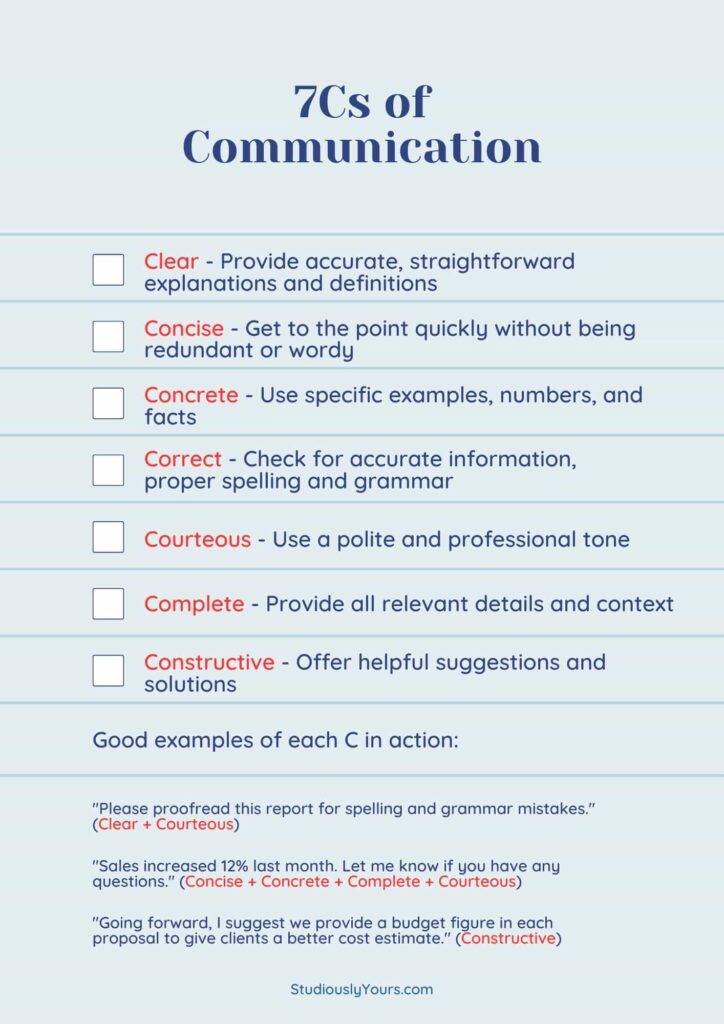The 7 Cs of communication – clear, concise, concrete, correct, courteous, complete and constructive – provide a useful checklist for sending effective messages in both professional and personal settings. Clarity, brevity and tact are key elements of communication that resonates with audiences. Mastery of the 7 C’s can help you craft emails, reports, presentations and discussions that accomplish desired outcomes.
- From customer service messages to employee communications, applying the 7Cs of effective communication will enhance your ability to connect and engage with others.
- Whether addressing supervisors, subordinates or service users, proper usage of these communication principles helps ensure messages are well-received and achieve intended purposes.
- Each of the 7 C’s reinforces good practices that optimize comprehension, trust and cooperation between communicators.
With relevant examples, learn how sharpening your use of clear, concise, concrete and other “C” words can make a real difference in the impact of your communications.
Download 7Cs of Communication With Examples PDF
Table of Contents
Explain 7 Cs of Communication With Examples
The 7 C’s of communication – clear, concise, concrete, correct, courteous, complete and constructive – provide a useful framework for ensuring that written and verbal messages are well-received by the intended audience. These principles emphasize the importance of precision, brevity and politeness in business and personal communications. Applying the 7Cs of effective communication helps optimize mutual understanding, trust and cooperation between communicators. With relevant examples, each of the 7 C’s can be explained and applied in practice to strengthen the clarity, impact and persuasiveness of your communications. When incorporated into your emails, reports, presentations and discussions on a consistent basis, the habits cultivated from utilizing the 7 C’s of communication can transform your ability to engage and connect with others.
Check 7Cs of effective communication with examples below.
| 7 Cs of Communication | Explanation | Example |
|---|---|---|
| Clear | Provide accurate, straightforward explanations and definitions | “We need to reduce costs by $1 million by the end of the quarter.” |
| Concise | Get to the point quickly without being redundant or wordy | Use bullet points instead of long paragraphs |
| Concrete | Use specific examples, numbers, and facts | “Sales increased by 12% last month compared to the same period last year.” |
| Correct | Check for accurate information, proper spelling and grammar | Have a colleague proofread your email before sending |
| Courteous | Use a polite and professional tone | Say “please” and “thank you.” Avoid harsh language |
| Complete | Provide all relevant details and context | Include an attachment with more information for those who need it |
| Constructive | Offer helpful suggestions and solutions | “Here are three things we can do to solve this problem…” |
Good examples of each C in action:
“Please proofread this report for spelling and grammar mistakes.” (Clear + Courteous)
“Sales increased 12% last month. Let me know if you have any questions.” (Concise + Concrete + Complete + Courteous)
“Going forward, I suggest we provide a budget figure in each proposal to give clients a better cost estimate.” (Constructive)

With consistent practice and feedback, the 7 C’s can become habitual approaches that improve all your communications! Let me know if you have any other questions.
Below we have explained the 7Cs of business communication
- Clear – Communication should be simple, straightforward and unambiguous to avoid confusion. Use plain language and define any jargon or technical terms.
- Concise – Get to the point quickly and communicate the key messages in the fewest words possible. Avoid unnecessary details.
- Concrete – Use specific examples, numbers, and facts to illustrate your points. Avoid vague language.
- Correct – Check your communications for accuracy, consistency and correct spelling and grammar. Facts should be verifiable.
- Courteous – Be polite, respectful and professional in your tone. Avoid sarcasm, arguments and threats.
- Complete – Provide all relevant information and context needed for the recipient to understand the communication. Leave no open gaps.
- Constructive – Offer suggestions or solutions where appropriate. Focus on moving forward in a positive manner rather than dwelling on problems. Provide positive and negative feedback strategically.
The 7 C’s represent helpful guidelines for effective workplace communication. They emphasize qualities like clarity, brevity, accuracy and tact, which help ensure communications are well-received and accomplish desired outcomes. Consistently applying these principles can improve communication in areas like emails, reports, presentations, discussions and more.
Idioms on Science and Technology – You Must Know!
Importance of 7Cs of Communication
The 7 C’s of communication are an important framework for crafting effective messages that resonate with audiences. Here are some reasons why mastering the 7 C’s is important:
- They optimize comprehension and minimize misunderstandings. Using clear, concise, and concrete language makes it easier for others to understand your intended meaning. This reduces the chances of miscommunication and confusion.
- They build trust and credibility. Communicating information that is correct, complete, and evidence-based helps establish you as a reliable source. This builds trust in your communications over time.
- They foster positive relationships. Being courteous and respectful in your communications helps create goodwill. Constructive feedback can strengthen relationships by focusing on improvement rather than criticism.
- They improve information retention. Clear, concise messages that get straight to the point are more likely to be remembered and acted upon by the recipient. Reducing “noise” maximizes retention of key information.
- They demonstrate professionalism. Mastering the habits of the 7 C’s signals a greater level of polish, preparation and attention to detail – hallmarks of a professional communicator.
- They increase influence. Communications that are easy to understand, credible and courteous are more likely to persuade and motivate others to take desired actions.
- They enhance performance. Improved communication minimizes delays, rework and errors caused by misunderstandings. It allows teams to operate more efficiently.
How can I improve my communication skills using the 7 C’s?
Here are some ways you can improve your communication skills by applying the 7 C’s:
- Practice clarity. Avoid jargon, ambiguity and vagueness. Define technical terms. Use simple, direct language.
- Be concise. Get straight to the point. Cut unnecessary words. Practice editing your communications down to the essentials.
- Provide concrete details. Use specific examples, numbers, facts and evidence to illustrate and support your key messages.
- Check for accuracy. Proofread carefully for spelling and grammatical errors. Verify facts and figures before communicating them.
- Adopt a courteous tone. Be polite, respectful and avoid harsh language. Use “please” and “thank you.” Watch your volume and pace of speech.
- Provide all relevant context. Explain acronyms. Summarize important background information. Offer to provide more details for those who need it.
- Focus on solutions. Offer helpful suggestions, recommendations or next steps wherever possible. Shift the focus from problems to progress.
- Practice active listening. Ask clarifying questions and summarize to check your understanding.
- Solicit feedback. Ask colleagues to point out areas for improvement based on the 7 C’s.
- Record yourself. Review video or audio of your speaking to identify areas for clearer, more concise communication.
- Write it down. Drafting emails, reports or presentations using the 7 C’s can develop better habits for verbal communication too.
The key is consistent practice and seeking feedback over time. Breaking larger communications into shorter chunks can also help make them more “C-focused.” As you improve one or two C’s at first, your skills across all seven will gradually strengthen.
With patience and perseverance, applying the 7 C’s framework can noticeably improve the effectiveness and impact of your communication, both written and spoken! Let me know if you have any other questions.
What are some common mistakes to avoid when applying the 7 C’s?
Here are some common mistakes to avoid when applying the 7 C’s of communication:
- Being vague instead of clear. Using ambiguous words and phrases instead of precise language that leaves no room for misinterpretation.
- Being wordy instead of concise. Rambling or including extraneous details that do not directly support your key message.
- Lacking concrete details. Failing to provide specific examples, numbers, evidence to illustrate your point. Relying too much on vague generalities.
- Inaccuracies in content. Providing incorrect information due to not thoroughly fact checking or proofreading your communications.
- An impolite or rude tone of voice. Speaking in a harsh, angry or impatient manner. Failing to use courtesy words like “please” and “thank you.”
- Leaving out relevant context. Failing to fully explain necessary background or definitions for an external audience. Forgetting to provide attachments for those who need more information.
- Focusing on problems, not solutions. Dwelling on negative issues rather than putting forth helpful suggestions for resolution or improvement.
Other common mistakes:
- Interrupting and failing to listen actively. Not pausing to ask clarifying questions or summarize key points.
- Declining feedback. Refusing opportunities to improve based on the 7 C’s when others offer constructive input.
- Not proofreading and editing written communications. Missing small errors in spelling, grammar or consistency that undermine your credibility.
Avoiding these common traps will improve your ability to apply the 7 C’s of communication effectively. The key is to develop good communication habits that optimize clarity, brevity, tact, courtesy and reliability – the hallmarks of truly resonating with one’s intended audience.
FAQs on the 7 C’s of Communication
The 7 C’s of communication are: clear, concise, concrete, correct, courteous, complete and constructive. They provide guidelines for crafting messages that communicate effectively.
The 7 C’s improve comprehension, build credibility and foster better relationships. They ensure messages are well-received and achieve desired outcomes. Mastering the 7 C’s enhances professionalism and influence.
The 7 C’s were originally developed by management consultants and business communication experts. There is no single person credited with discovering them.
While the 7 C’s framework is well-known, the key principles of clarity, conciseness and courtesy likely encompass most of what is required for effective communication. Mastery of even a few of the 7 C’s can significantly improve how you connect and engage with others. The ultimate goal is creating communications that resonate with the intended audience.
At Studiously Yours Blog you can get 7Cs of communication PDF.



0 Comments